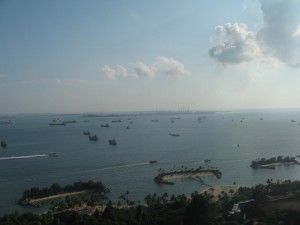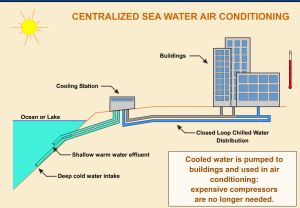Remember my previous post “Water Body”? Well, this is the sequel. Water Body v1.2
Seawater Body.
Water Body was all about how there are various ways to cool a city down, and I introduced a concept, Deep Water Source Cooling (abbreviated DWSC), that makes use of ponds/ reservoirs i.e. bodies of water to replace air-conditioning. I discussed a little of its limitations, but recently I read about this: Sea-water air-conditioning.
Similar to the concept of DWSC, water is drawn from the lower depths, pass it through a heat exchange unit and the warmed water is discharged and returned. MAKAI, the company marketing this system, claims that it can save 90% of the energy used in air-conditioners that rely on air compressors (1). Perfect. Furthermore we do not use up fossil fuels in this method of cooling, alleviating a host of problems like global warming and air pollution.
Remember how I criticized DWSC to be unfeasible in Singapore as we are summer all year round? Well, nature has a robust answer. Thanks to oceanic convection currents, i.e. difference in temperature between the equator and the poles that produce a huge global-scale convection, sea water will be more cool, for one, and also there’s no worry that constant discharging of warmer water will cause the temperature of the said water body to rise insidiously without decreasing, as will be the case for closed systems like ponds/ reservoirs.
Even though the deep seawater around the equator may not be as cool, MAKAI has estimated that the energy usage of this system will still be 1/4 of that of a conventional compressor air-conditioner (1). Interesting times ahead, considering Singapore is a city-island surrounded by water.
Viable? Maybe. Some places in Hong Kong for example are currently doing it. Will it happen? We never know. Considering our rampant land reclamation projects at hand, installing pipelines that restrict our ‘growth’ may not be exactly what the government has in mind.
^^cheers
References
- Sea Water Air Conditioning | Makai Ocean Engineering. Makai.com. Retrieved 15 September 2016, from http://www.makai.com/sea-water-air-conditioning/


Hi Mak,
Hmm that’s a rather interesting reductionist (?) solution to address the heat situation in cities. Whilst I feel that this idea can be used in coastal areas, what about areas which are located further from the sea yet utilise vast amounts of cooling units (and consequently high energy use) ? Won’t the water in the pipes equilibrate towards the average temperature and reduce their efficiency? Hope to hear your thoughts about this! 🙂
-Choo
Yep, you’re right it is a reductionist approach in solving the issue. Though acknowledging that an improvement in technology not necessary leads to decrease usage of energy, but maybe a copious careless mindset of waste instead, I still feel that if the resource is 100% renewable, and furthermore if it truly is able to decrease ocean temperatures, an overabundant usage doesn’t seem too sticky a problem for me.
As of now this technology can only be harnessed by coastal areas, this is a limitation in using this technology. Hope this answers your question!
no – one of the 6 cases they talk about is Toronto, which is > 700 km from Atlantic coast and is using water from Lake Ontario.